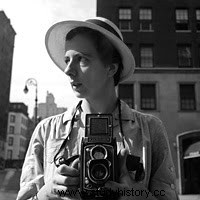Vivian Maier (1926 – 2009) was an American street photographer whose impressive work was discovered by chance after her death.
Initiation to photography
 Daughter of Maria Jaussaud, French, and Charles Maier, American from Austrian emigrants, Vivian Maier was born on February 1, 1926 in New York. She has a big brother six years older than her, Charles William. When the little girl was three years old, her parents separated and she was entrusted to her mother while her brother went to live with her paternal grandparents. Maria and Vivian then settled in the Bronx, with a photographer friend, Jeanne Bertrand. She was the first to introduce Maria and her daughter to photography.
Daughter of Maria Jaussaud, French, and Charles Maier, American from Austrian emigrants, Vivian Maier was born on February 1, 1926 in New York. She has a big brother six years older than her, Charles William. When the little girl was three years old, her parents separated and she was entrusted to her mother while her brother went to live with her paternal grandparents. Maria and Vivian then settled in the Bronx, with a photographer friend, Jeanne Bertrand. She was the first to introduce Maria and her daughter to photography.
In 1932 or 1933, Jeanne, Maria and Vivian moved to France. They lived for a while in Saint-Julien-en-Champsaur, Maria's native village located in the Hautes-Alpes, then just next door in Saint-Bonnet-en-Champsaur. Vivian spent several childhood years there, learning French and playing with children her age while her mother took photos of their stay. In 1938, Maria and her daughter, who was then twelve, moved back to New York. Vivian will return to France a dozen years later to sell a property she inherited. During the time she spends in the Hautes-Alpes, she visits her family and, with two cameras slung over her shoulder, takes many pictures.
A secret job
In 1951, living in New York, Vivian Maier entered the service of a family as a nanny. At the same time, she buys a professional camera and continues to indulge discreetly in her passion. In 1956, she entered the service of Nancy and Avron Gensburg, in Chicago, still as a babysitter. In her spare time, she travels the streets with her camera to immortalize scenes of life, inhabitants, passers-by, and develops her negatives in her private bathroom. Secret, she does not show her pictures and does not talk about her work. Between 1959 and 1960, she undertook a trip around the world and visited in particular Thailand, Yemen, Egypt, Canada, Italy and again France and the region of her mother's birth.
With the three Gensburg children grown up, Vivian left the family she worked with for seventeen years and continued to work as a nanny to other families. After always working in black and white, she finally moved on to color photography. No longer having private spaces to transform into a darkroom like at the Gensburgs, she no longer develops her photos but does not stop taking them and accumulates many negatives and photographic films. When she changes employers, she drags a significant number of boxes with her. In 1987, she warned Karen and Zalman Usiskin, her future employers, "I have to tell you that I come with my life, and my life is in boxes."
The accident
From 1989 to 1993, Vivian Maier, who is beginning to age, takes care of Chiara Bayleander, a mentally handicapped teenager. Subsequently, with old age, she experienced financial difficulties and could no longer pay for the storage of her many boxes in a storage unit; his belongings, including his cameras, negatives and films, are then auctioned off and sold. The Gensburgs, with whom Vivian has remained in contact, move her into an apartment in Rogers Park. In December 2008, she slipped on a patch of ice and suffered a severe blow to the head. Installed by the Gensburgs in a nursing home, she died despite everything on April 20, 2009.
Discovery
Two years earlier, in 2007, John Maloof, a young real estate agent looking to illustrate a book on a Chicago neighborhood, bought a lot of 30,000 negatives at auction. Not finding the pictures he was looking for, he left them in a closet for several months before realizing the quality of these images and the treasure he had discovered. He then embarked on a major digitization work and undertook to buy back the other negatives sold at auction the same day. In total, he acquires more than 100,000 negatives and, seeking to find their author, learns that they belonged to an anonymous old lady. It was not until 2009 that he found an envelope bearing the name of Vivian Maier in a box... and that he learned that she had died a few days earlier.
John Maloof then embarked on a major investigation of Vivian and the protection of her work. He interviews his relatives, reconstructs his story, seeks to discover his personality; he creates a website for her and classifies and sorts her negatives. In 2011, he brought Vivian's story to the world through his book Vivian Maier, Street Photographer , which was very successful. The story of this nanny who secretly took around 120,000 street photos without having seen a good part of them herself for lack of being able to develop them, and without having tried to profit from them, arouses curiosity. The richness and quality of her work make her recognized as a great photographer. His pictures are imbued with humanism, full of tenderness for the marginalized, the poor, the left behind; they are of all genres:portraits, landscapes, still lifes, and sometimes also some self-portraits.
His work has been the subject of exhibitions in galleries in New York, Houston, Los Angeles, Atlanta, Chicago, Fribourg, but also in Saint-Julien-en-Champsaur, the native village of his mother.
